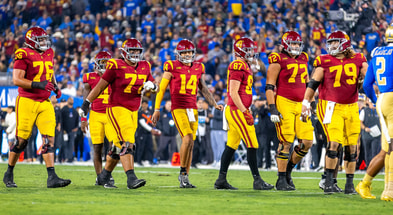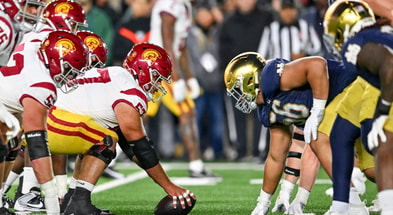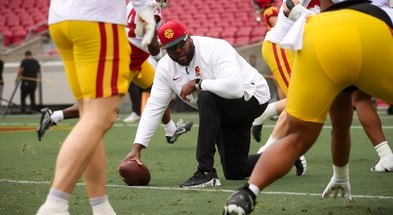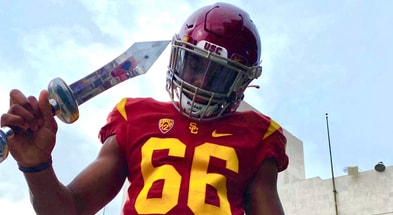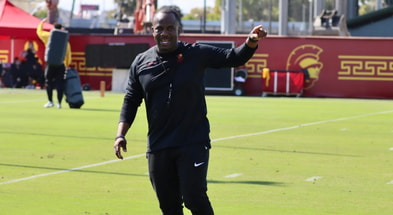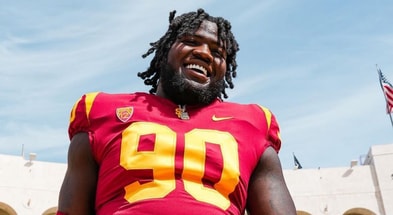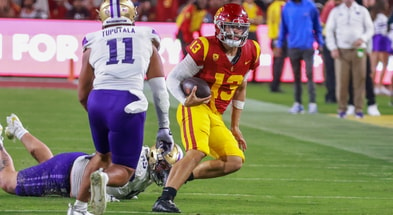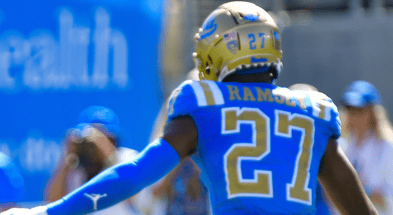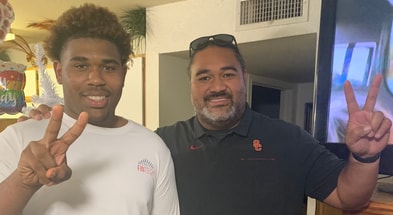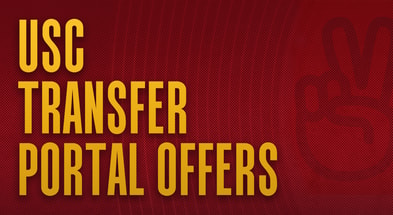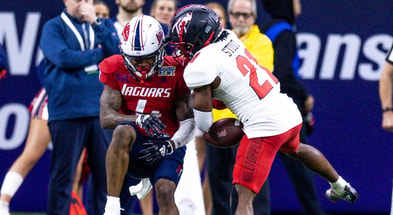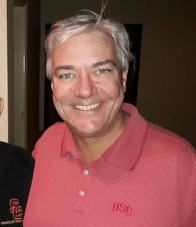O/NSO: A defensive front for national championship success edition
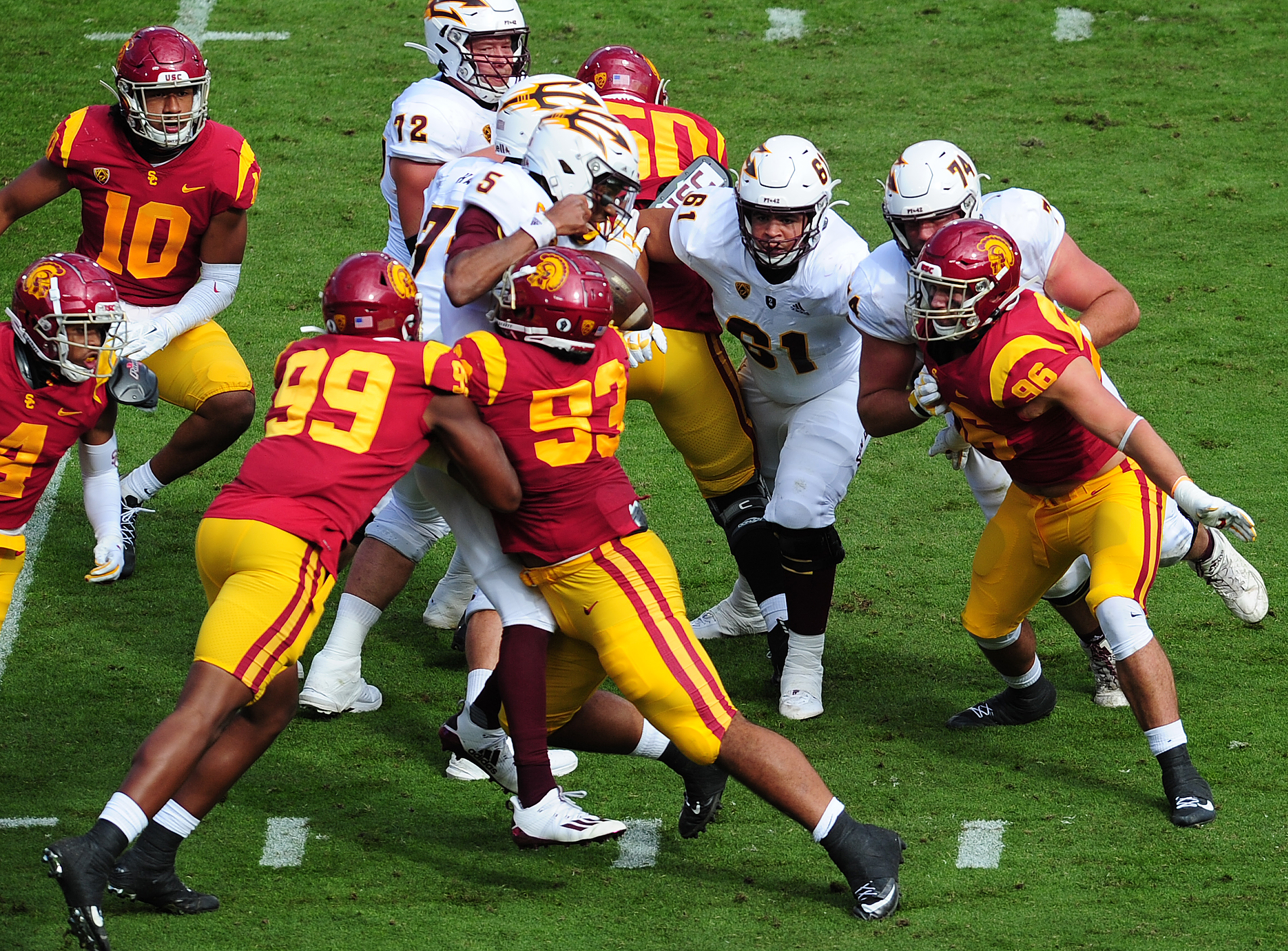
The Obvious: When the Trojans take to the Coliseum turf on Saturday afternoon (1 p.m. PDT/ Pac-12 Networks) for an event called the “The Spring Showcase” (AKA The Spring Game), those watching both inside or outside the Grand Old Lady will probably focus on the new skill people and the already highly scrutinized offensive line.
The Not So Obvious: However, it would be a dereliction of duty for cardinal and gold fans to ignore the work-in-progress Trojans’ defensive line, which also must fill important spots along that front wall. If the Trojans are going to make a run at the 2021 Pac-12 title, they’ll need to follow in the footsteps of previous elite USC conference championship defensive lines. And if the ultimate goal is a CFP National Championship, this upcoming season’s defensive front will also have to play at a level comparable to those past glorified Trojans’ national champions.
The Obvious: When folks think of the modern era national championships at the University of Southern California (1962 – present), most first romance about Tailback U. or Quarterback U. or O-line U. or Wide Receiver U. That’s a whole lot of “U” titles, but for all the electricity of the USC national championship offenses, it’s the Trojans’ defenses of those title teams that deserve full attention and recognition, and it begins with the defensive line.
The Not So Obvious: Whether it’s been the national championship eras of John McKay, John Robinson, or Pete Carroll, the common thread is tough, athletic defensive linemen that worked as a unit under legendary USC D-line coaches like Marv Goux and Ed Orgeron, respectively. Both men developed a number of intimidating defensive linemen, and many of their protégés went on to successful professional football careers.
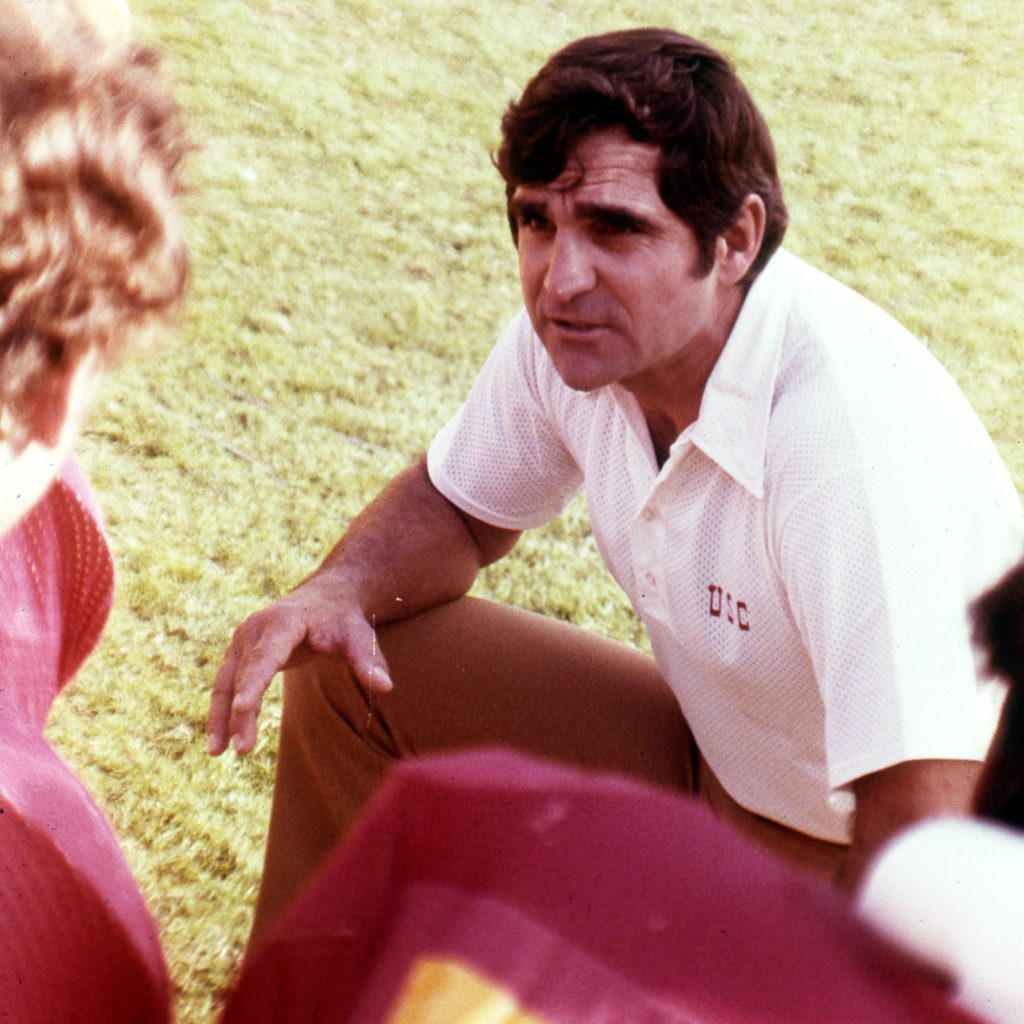
The Obvious: Not surprisingly, all of the listed national championship teams of the modern era had All-Americans at one time or another regardless of the defensive numbers sets.
The Not So Obvious: In reality, the Trojans could argue their case that when it comes to defensive linemen, they generally don’t take a backseat to other notable national powers – especially when it comes to national championships.
The Obvious: Thanks to a 51-0 shellacking in the Coliseum by Notre Dame in 1966, Trojans legendary head coach John McKay afterwards set out to find defensive linemen that could withstand or even dominate their Irish rival’s offensive lines. Seriously, who scores 51 points against a John McKay defense? Apparently, the answer was the physical offense of arch-rival Notre Dame. So, never again in the McKay area would the proud Trojans head coach allow one of his teams to be embarrassed like that on a Saturday afternoon against the Irish.
The Not So Obvious: McKay lived up to his word by not only recruiting the biggest and best locally but nationally, as well. The Trojans brought in players from distant locales like Cleveland, Ohio; Bayonne, New Jersey; Phoenix, Illinois; St. Joseph, Louisiana; and even Boise, Idaho. McKay’s Trojans might lose to the Irish in the future but not 51-0.
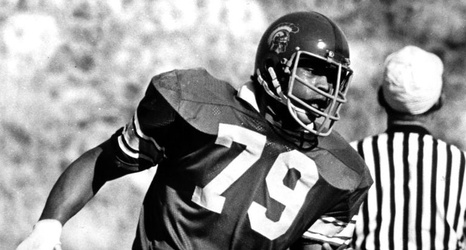
The Obvious: There’s the old football adage that says that offense scores points but defense wins championships.
The Not So Obvious: To illustrate the aforementioned proverb, below are all the modern era USC national championship defensive lines, and again pay particular attention to the increase in size from 1962 and where these tremendous athletes called home.
The Obvious: In 1962, the Trojans first national championship (11-0) under John McKay, the Trojans’ defensive line was not big in statue, but if ever a defense won a national title without overwhelming size, there’s no question this McKay defensive team was the template. Defensively, the Trojans allowed just 8.4 points per while the offense averaged 23.7 points per outing.
The Not So Obvious: The 1962 Trojans starting defensive line for McKay’s first national title included nose guard Pete Lubisich (6-1, 210/ Burbank, Calif.), tackles Marv Marinovich (6-3, 225/ Watsonville, Calif.), Gary Kirner (6-3. 213/ Los Angeles), and Bill Fisk Jr. (6-0, 220/ San Gabriel, Calif.). The defensive line was coached by the soon-to-be legendary Marv Goux.
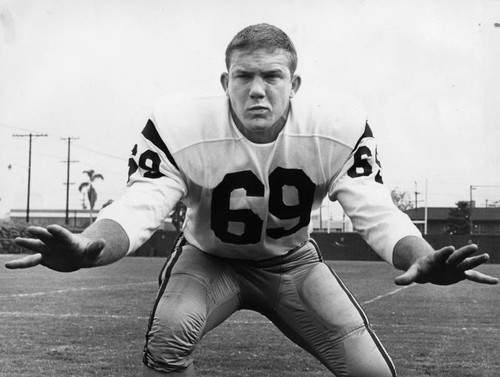
All-Star and/or NFL recognition went to team captain Marv Marinovich, who was taken in the 11th round by the Los Angeles Rams in the 1962 NFL draft. Underclassman and All-AAWU tackle Gary Kirner would later be selected in 5th round of the 1964 AFL draft by the San Diego Chargers. In 1964, Bill Fisk would become an All-American and then transition into coaching and eventually the head coach at Mt. San Antonio College. Senior Pete Lubisich went undrafted but eventually became a pediatric dentist.
The Obvious: The 1967 USC National Champions (10-1-0) began to show increased size on the defensive line. This D-line group was really tough, and four of five starters would be drafted and play professional football. Defensively, the Trojans allowed 7.9 points per while the offense averaged 23.5 points per contest. The 1967 defense finished the season by controlling Indiana, 14-3, in the 1968 Rose Bowl Game.
The Not So Obvious: The 1967 5-2 defense included nose guard Ralph “Chip” Oliver (6-1, 220/ San Diego, Calif.), tackles Gary Magner (6-5, 245/ Costa Mesa, Calif.) and Willard “Bubba” Scott (6-1, 245/ Los Angeles), and standup defensive ends Tim Rossovich (6-5, 235/ Mountain View, Calif.) and Jimmy Gunn (6-1, 210/ San Diego, Calif.). The defensive line was coached by Marv Goux.
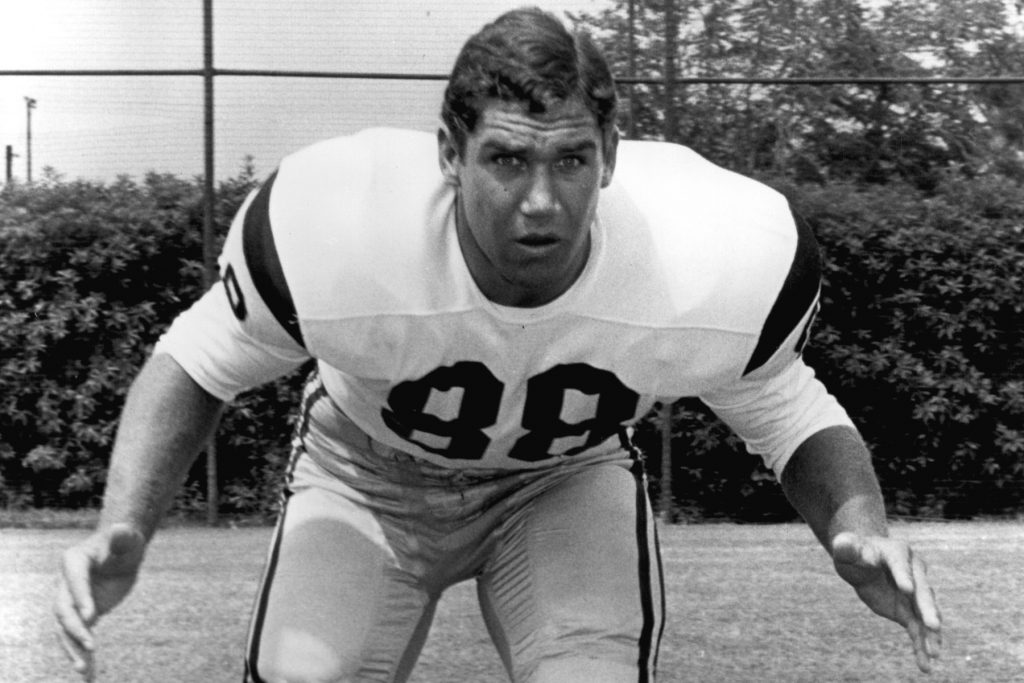
All-Star and/or NFL recognition went to All-American Tim Rossovich, who would be taken in the 1st round by the Philadelphia Eagles in the 1968 NFL draft. In the same draft, Gary Magner would be selected in the 4th round by the New York Jets while Ralph Oliver was chosen in the 11th round by the Oakland Raiders. Willard Scott and Jimmy Gunn, who would become a two-time All-AAWU pick, were both underclassmen, but Gunn would later be drafted in the 13th round in the 1970 NFL draft by the Chicago Bears. Scott would go on to cardinal and gold immortality as a starting member of the legendary 1979 Wild Bunch defensive line.
The Obvious: The 1972 USC National Champions (12-0), arguably the greatest college football team of all-time, continued to increase in size and ability so dramatically that when that defensive line finished the season with a crushing, 42-17, domination of Ohio State’s famed power running game in the 1973 Rose Bowl, there was little doubt that USC was not only Tailback U. but D-line U., as well. Defensively, the No. 1 Trojans allowed 11.2 points per game while the offense averaged 38.9 points per game.
The Not So Obvious: The 1972 5-2 defensive down linemen included nose guard Monte Doris (6-4, 245/ Fresno, Calif.) and tackles John Grant (6-5, 229/ Boise, Idaho) and Jeff Winans (6-4, 245/ Turlock, Calif.), and standup defensive ends Dale Mitchell (6-3, 206/ Carlsbad, Calif.) and James Sims (6-0, 192/ Los Angeles). The defensive line was coached by Marv Goux.
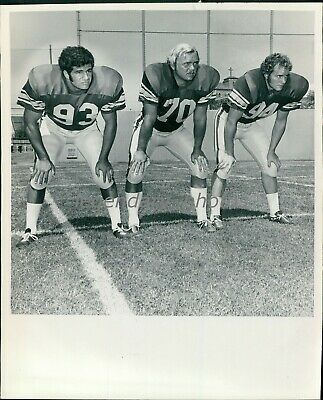
All-Star and/or NFL recognition went to All-American John Grant, who was drafted in the 7th round by the Denver Broncos in the 1973 draft. Jeff Winans would join Grant in the 1973 draft by being selected in the 2nd round by the Buffalo Bills. Underclassmen Monte Doris would eventually become All-Pac-8 in 1973 and would be drafted in the 8th round of the 1974 NFL draft by the Green Bay Packers. While senior James Sims was named All-Pac-8 in 1972 but was not drafted, underclassman Dale Mitchell would be taken in the 13th round by the San Francisco 49ers in the 1975 NFL draft.
The Obvious: The 1974 USC National Champions (10-1-1) were John McKay’s fourth and final national title team, which featured a typically tough and physical defensive line. Four of those D-linemen went on to the NFL. Defensively, the Trojans allowed 11.8 points per while the offense averaged 30.2 points per game. The Trojans competed their national championship season with a heart-stopping, 18-17, defensive slugfest squeaker in the 1975 Rose Bowl Game.
Top 10
- 1New
Amir Khan
Viral manager to the portal
- 2
Rodney Terry
Texas' next step, favorite
- 3
Nate Oats
Reacts to Will Wade handling of NC State
- 4Hot
CBS announcer
Rips officials in St. John's, Arkansas
- 5Trending
Tip times announced
Sunday NCAA games times, TV revealed
Get the On3 Top 10 to your inbox every morning
By clicking "Subscribe to Newsletter", I agree to On3's Privacy Notice, Terms, and use of my personal information described therein.
The Not So Obvious: The 1974 5-2 inside defensive linemen included nose guard Otha Bradley (6-2, 263/ St. Joseph, Louisiana) and tackles Art Riley (6-4, 248/ Phoenix, Illinois) and Gary Jeter (6-4, 255/ Cleveland, Ohio), and standup defensive ends Dale Mitchell (6-3, 206/ Carlsbad) and Ed Powell (6-1, 219/ Richmond, Calif.). The defensive line was coached by Marv Goux.

All-Star and/or NFL recognition went to All-Pac-8 tackle Art Riley, who was taken in the 2nd round of the 1975 NFL draft by the Minnesota Vikings, and in the same draft, Otha Bradley was selected in the 10th round by the San Diego Chargers while defensive end Dale Mitchell taken in the 13th round by the San Francisco 49’ers. In the future, Gary Jeter, who was All-Pac-8 in 1974, would go on to become an All-American in 1976 and was a 1st round draft pick of the New York Giants in the 1977 draft. Ed Powell was a 1974 All-Pac-8 selection.
The Obvious: The 1978 USC National Champions (12-1), now under head coach John Robinson, presented a defensive front that was again formidable. Defensively, the Trojans allowed 11.8 points per while the offense averaged 24.5 points per game and ended the season with a tough, 17-10, defensive victory over Michigan in the 1979 Rose Bowl Game.
The Not So Obvious: The 1978 5-2 inside defensive line included nose guard Richard Dimler (6-6, 255/ Bayonne, New Jersey) and tackles Myron Lapka (6-4, 245/ Chatsworth, Calif.) and Ty Sperling (6-0, 235/ Wilmington, Calif.) along with standup defensive ends/linebackers Garry Cobb (6-2, 215/ Samford, Conn.) and Larry McGrew (6-5, 220/ Berkeley, Calif.). The defensive line coach was Marv Goux.
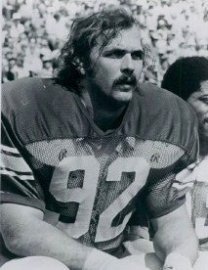
All-Star and/or NFL recognition was awarded to All-Pac-10 nose guard Richard Dimler, who was selected in the 5th round of the 1979 NFL draft by the Cleveland Browns while Garry Cobb was taken in the 9th round by the Dallas Cowboys. Larry McGrew would eventually be taken in the 1980 draft in the 2nd round by the New England Patriots while Myron Lapka would be selected in the 3rd round by the New York Giants.
The Obvious: The 2003 USC National Champions (12-1), under head coach Pete Carroll, attained their 10th national title, and the Trojans were on the precipice of a college dynasty, one for the ages. Defensively, the Trojans allowed 18.4 points per while the offense “averaged” a whopping 41.1 points per game, finishing the season by controlling Michigan, 28-14, in the 2004 Rose Bowl Game.
The Not So Obvious: The 2003 4-3 defensive line included tackles Shaun Cody (6-4, 295/ Hacienda Heights, Calif.) and Mike Patterson (6-0, 290/ Los Alamitos, Calif.), and defensive ends Kenechi Udeze (6-4, 285/ Los Angeles) and Frostee Rucker (6-3, 260/ Tustin, Calif.). The defensive line coach was the incomparable Ed Orgeron.
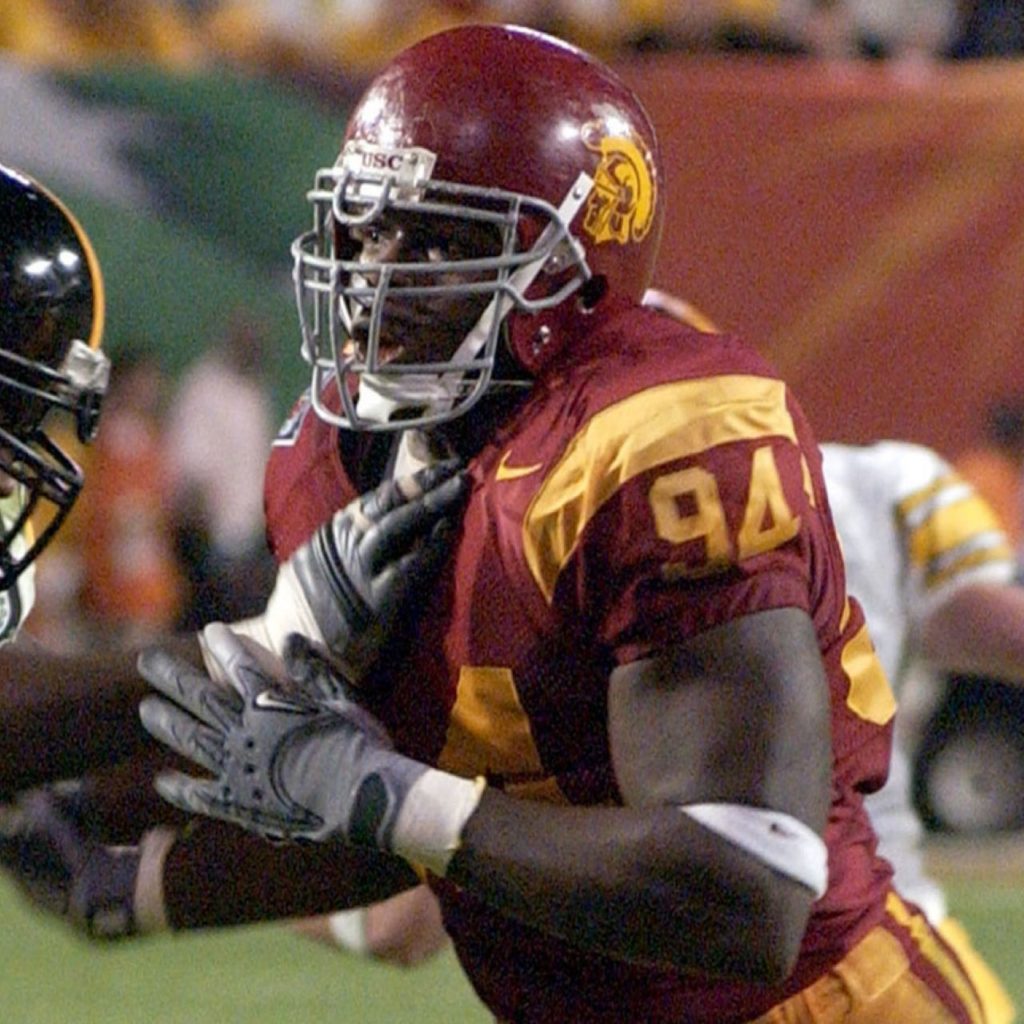
All-Star and/or NFL recognition included All-American Kenechi Udeze, who was a 2004 1st round draft pick of the Minnesota Vikings. Shaun Cody and Mike Patterson were named 2003 All-Pac-10 performers, and in 2005, Frostee Rucker would become All-Pac-10.
The Obvious: The 2004 USC National Champions (11-0) won their second consecutive national championship of the Pete Carroll era and the The Trojans 11th national title overall. Again the cupboard was filled with future NFL defensive line talent. The Trojans allowed 13.0 points per game while the offense averaged 38.2 points per game, finishing the season by completely annihilating Oklahoma, 55-19, in the 2005 Orange Bowl Game.
The Not So Obvious: The 4-3 defensive line for the 2004 USC National Champions included tackles Shaun Cody (6-4, 295/ Hacienda Heights, Calif.) and Mike Patterson (6-0, 290/ Los Alamitos, Calif.), and defensive ends Lawrence Jackson (6-5, 270/ Inglewood, Calif.) and Frostee Rucker (6-3, 260/ Tustin, Calif.). The defensive line coach was again Ed Orgeron.
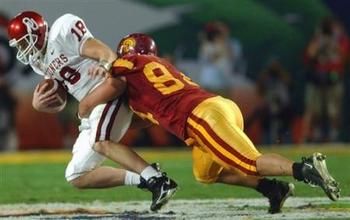
All-Star and/or NFL recognition went to All-Americans Mike Patterson and Shaun Cody, both of whom were taken in the 2005 NFL draft. Patterson was selected in the 1st round by the Philadelphia Eagles and Cody in the 2nd round by the Detroit Lions. Jackson would become an All-Pac-10 choice in 2005 and 2007 and a No. 1 pick of the Seattle Seahawks in 2008. Frostee Rucker would become All-Pac-10 in 2005 and a 3rd round pick of the Cincinnati Bengals in the 2006 NFL draft.
The Obvious: And finally, if you read last week’s O/NSO regarding the great offensive lines of the Trojans modern era national championship teams and combine them with this week’s reading of the defensive lines, you get a pretty good idea why the Trojans were national champions.
The Not So Obvious: If the Trojans are again to be a national force, they won’t be able to do it until the offensive and defensive lines have national championship linemen and that begins with recruiting, coaching, and winning.


